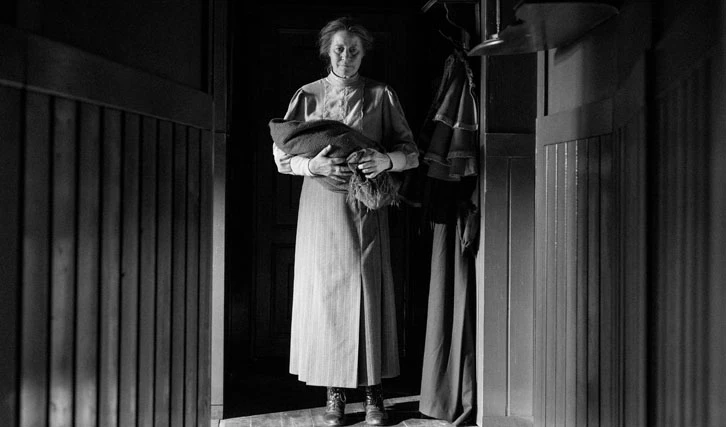Das Mädchen mit der Nadel: Eine Dunkle Reise in die Abgründe der Menschheit
In seinem Historiendrama "Das Mädchen mit der Nadel" entführt uns der schwedische Regisseur Magnus von Horn in die düstere Zeit kurz nach dem Ersten Weltkrieg. Die Geschichte um die dänische Serienmörderin Dagmar Overby, die unehelich geborene Babys gegen Geld an Adoptiveltern vermittelte und sie stattdessen tötete, fasziniert und verstört gleichermaßen. Ein Gespräch mit dem Regisseur über die Entstehung seines düsteren Schwarz-weiß-Films und seine stilistischen Vorbilder.
The Story So Far: A Dark Tale Unveiled
Magnus von Horn’s "Das Mädchen mit der Nadel" delves into the chilling narrative of Dagmar Overby, a Danish baby killer during the post-World War I era. The film navigates through the eerie depths of human nature, exploring the societal constructs and personal demons that drove Dagmar’s gruesome actions.
Unveiling the Depths of Human Darkness
Magnus von Horn, the mastermind behind this haunting tale, shares his journey into the heart of darkness that inspired "Das Mädchen mit der Nadel." His exploration of Dagmar Overby’s crimes unveils not only the horrors of her deeds but also the societal context that birthed such monstrosities.
The Impact of War on Innocence
Despite Denmark’s neutrality in the war, the echoes of conflict reverberate through the streets, shaping the narrative of despair and desperation that surrounds Dagmar’s story. The film masterfully weaves the threads of war-torn lives and shattered innocence, painting a poignant picture of the homefront battles fought by women like Karoline, the film’s central character.
Behind the Scenes: Crafting a Modern Horror
From the experimental visuals that set the stage to the unsettling soundtrack that haunts every frame, "Das Mädchen mit der Nadel" emerges as a modern horror masterpiece. Magnus von Horn’s deliberate choice of black and white aesthetics and contemporary soundscapes adds layers of complexity to an already chilling narrative.
Exploring the Depths of Human Nature
As the film unfolds, it delves into the complexities of human nature, blurring the lines between good and evil, innocence and depravity. Karoline’s journey from naivety to resilience mirrors the audience’s own introspection, forcing us to confront the darkness within and around us.
Conclusion
"Das Mädchen mit der Nadel" is a haunting exploration of the darkest corners of the human soul, a journey that challenges our perceptions and leaves us questioning the thin line between good and evil. Magnus von Horn’s masterful storytelling and bold visual choices create a cinematic experience that lingers long after the credits roll.
Frequently Asked Questions
- Is "Das Mädchen mit der Nadel" based on a true story?
- Yes, the film is inspired by the chilling true story of Danish baby killer Dagmar Overby.
- What influenced Magnus von Horn’s decision to film in black and white?
- The choice of black and white aesthetics was a deliberate attempt to transport viewers to a bygone era and create a timeless, haunting atmosphere.
- How did the director approach the casting process for the film?
- Magnus von Horn meticulously selected actors who could embody the raw emotions and complexities of the characters, ensuring a captivating and immersive experience for the audience.
- What role does the soundtrack play in enhancing the film’s narrative?
- The modern, experimental soundtrack adds a layer of unease and tension, heightening the emotional impact of key scenes and underscoring the film’s themes of darkness and despair.
- Why is "Das Mädchen mit der Nadel" considered a horror film?
- While the film transcends traditional genre boundaries, its exploration of human darkness and the eerie atmosphere created by the visuals and soundtrack align it with the horror genre.
- What message does the film convey about society and human nature?
- Through the lens of Dagmar Overby’s crimes, the film delves into the societal constructs and personal demons that drive individuals to commit heinous acts, sparking reflections on the darker aspects of human nature.
- How does the film portray the impact of war on the characters’ lives?
- Despite Denmark’s neutrality, the film illustrates the profound effects of war on the characters, shaping their decisions and interactions in a world torn apart by conflict.
- What role does symbolism play in "Das Mädchen mit der Nadel"?
- Symbolism is woven throughout the film, from the stark black and white visuals to the haunting soundtrack, adding layers of meaning and depth to the narrative.
- How does the film explore the theme of resilience in the face of darkness?
- Characters like Karoline exemplify resilience, navigating through the darkness and despair to find strength and purpose amidst the chaos.
- What sets "Das Mädchen mit der Nadel" apart from other historical dramas?
- The film’s bold visual choices, haunting narrative, and profound exploration of human nature set it apart, offering a unique and immersive cinematic experience for audiences.
Tags: Das Mädchen mit der Nadel, Magnus von Horn, Dagmar Overby, Historical Drama, Horror Film, Black and White Aesthetics
- The film’s bold visual choices, haunting narrative, and profound exploration of human nature set it apart, offering a unique and immersive cinematic experience for audiences.

